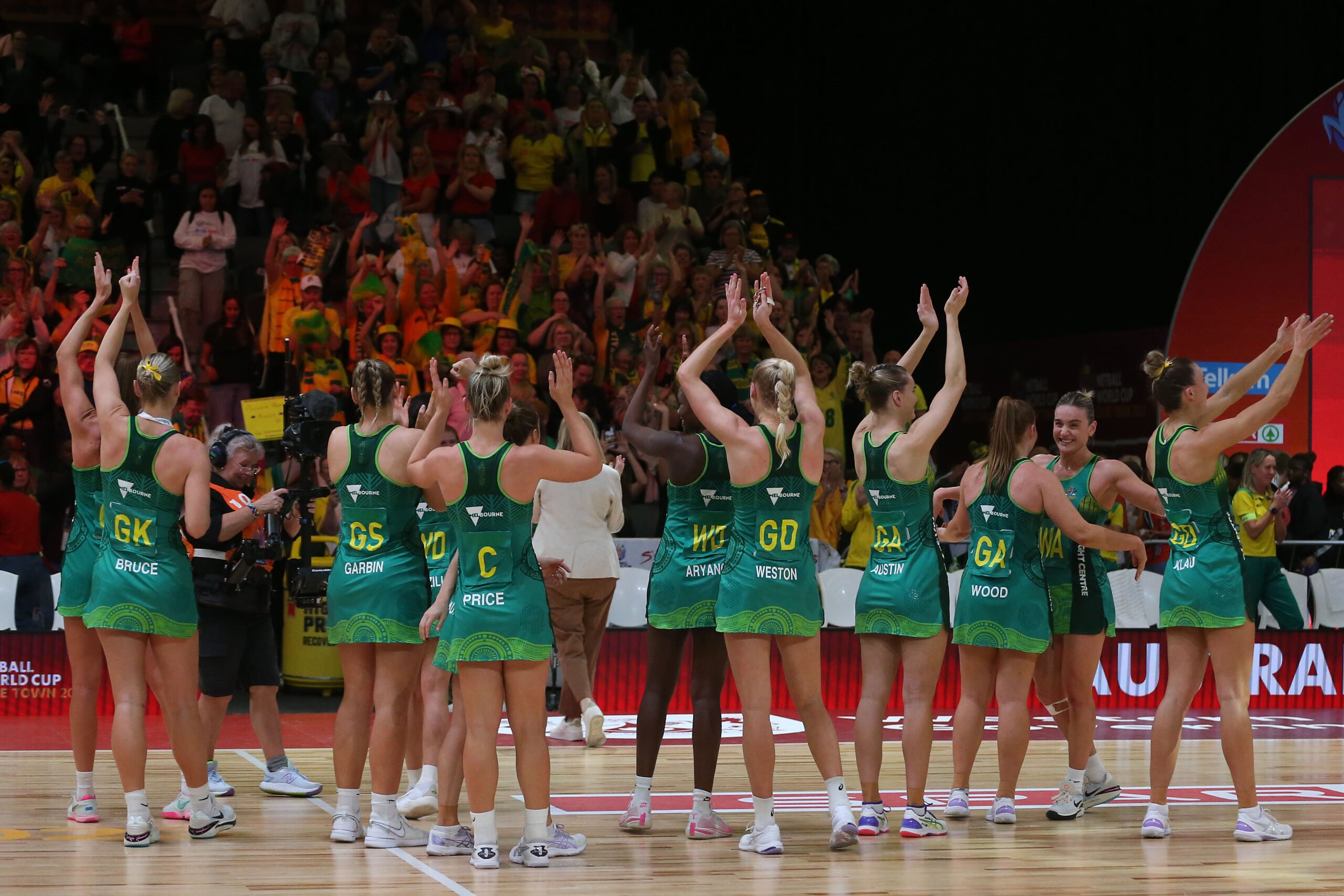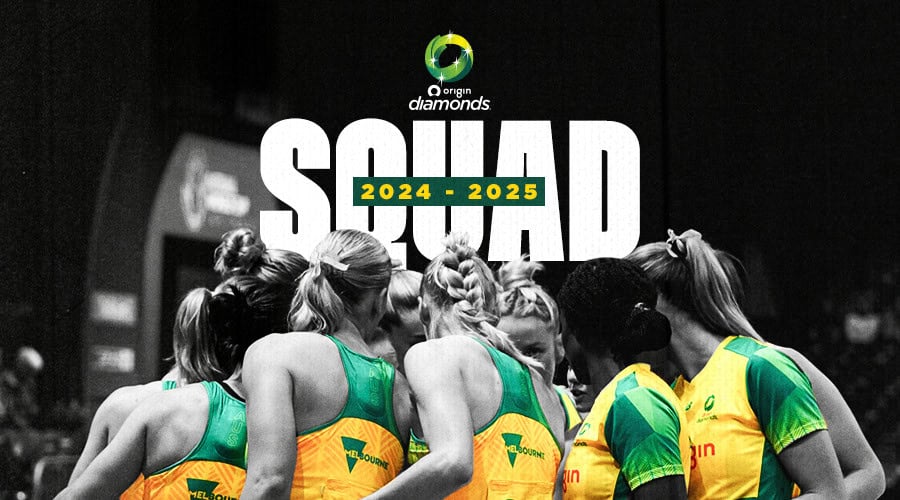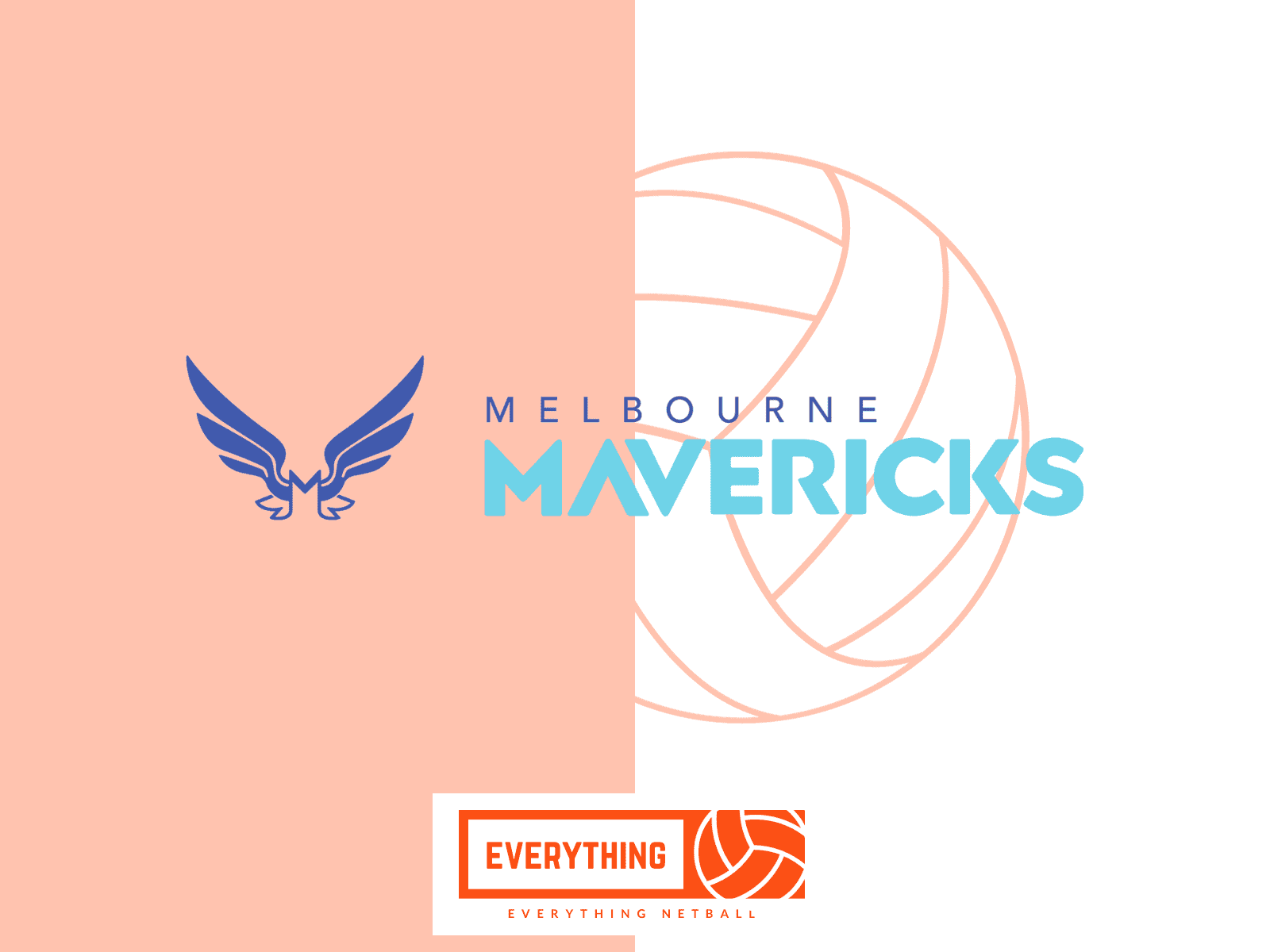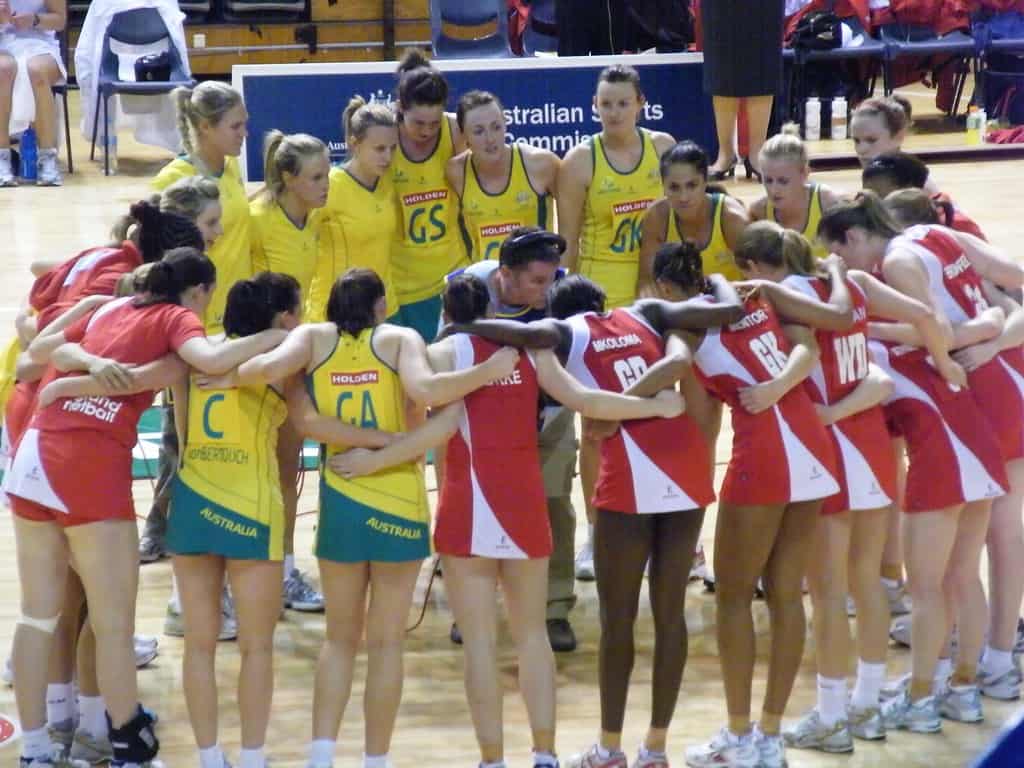As I step onto the netball court, I am immediately swept up in the intricate dance of positions and roles. Like a well-oiled machine, each player moves with purpose and precision, knowing exactly where they belong.
In this game of strategy and skill, understanding netball positions is the key to success.
With seven players on court, each player has a specific zone they must stay within, ensuring a fair and balanced game. From the defensive players who guard their territory with unwavering determination, to the center player who controls the heart of the court, to the attacking players who work together to score points, every position has its own responsibilities and areas of expertise.
In this article, we will delve into the world of netball positions, exploring their intricacies and shedding light on the roles they play.
So join me as we unravel the mysteries of netball positions and unlock the secrets to mastering this thrilling sport.
Key Takeaways
– Netball positions include Goal Keeper (GK), Goal Defence (GD), Wing Defence (WD), Centre (C), Wing Attack (WA), Goal Attack (GA), and Goal Shooter (GS).
– Players must stay within their designated zones on the court to avoid penalties.
– Defensive players (Wing Defence, Goal Defense, and Goal Keeper) stay inside their own defensive zone and have specific roles to limit the other team scoring.
– Center players control the middle section of the court, are responsible for throwing the center pass into play, and play a crucial role in both attack and defense.
Netball Positions Explained
In a standard netball game, there a 7 players on the court and 2+ substitutes on the side line. These positions are:
- Goal Shooter (GS)
- Goal Attack (GA),
- Wing Attack (WA),
- Centre (C),
- Wing Defence (WD)
- Goal Defence (GD),
- Goal Keeper (GK)
In netball, each position plays crucial roles in a team’s offense and defense.
Understanding their responsibilities and movements on the court is essential for effective gameplay.
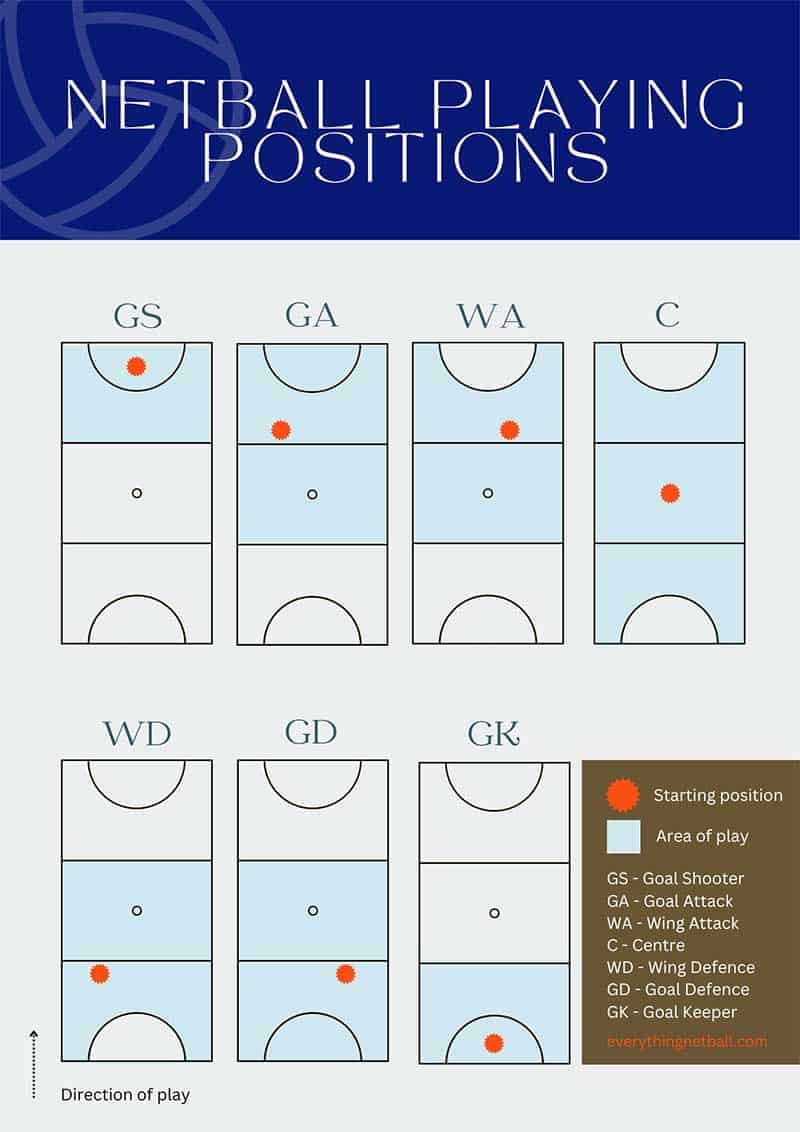
TL:DR – Playing Positions in netball
The Goal Shooter’s main role is to score goals for their team, while the Goal Attack provides support and is also allowed to shoot. Goal Shooter and Goal Attack are crucial positions on the court and need to work seamlessly with one another and their Wing Attack and Centre to move the ball through the attacking third of the court.
The Wing Attack focuses on feeding the ball into the shooting circle, the Centre controls the middle of the court with the goal of the ball reaching the goal circle, and the Wing Defence works to intercept passes and disrupt the opponent’s attack.
The defensive positions control the oppositions attacking zone, working together to prevent them from scoring.
Goal Shooter (GS)
The Goal Shooter (GS) is an absolute scoring machine, lighting up the court with their impressive shooting skills and leaving defenders in awe.
As a GS, your role is crucial in the team’s offense, as your are responsible for shooting goals and earning points for your team.
To be an effective GS, you have to master your shooting techniques. Accuracy is key, so focusing on your aim and working on your shooting skills through training drills specifically designed for goal shooters is a great start.
Strategies for goal shooting include creating space, positioning yourself within shooting range, and having good communication with your teammates.
Being a GS requires patience, agility, and the ability to read the game.
For more information on the Goal Goal players role, check out this Goal Goal Position Guide.
Goal Attack (GA)
The Goal Attack (GA) is a crucial position in netball, requiring lightning-fast footwork and quick thinking to be the playmaker of the team. As the GA, it’s important to understand various netball strategies to excel in this position.
One key technique for the GA is knowing how to create space and position yourself to receive passes from the Wing Attack (WA) and Center (C) players. This involves using clever footwork and body positioning to outmaneuver defenders and make yourself available for a pass.
In addition to creating space, goal shooting tips are essential for the GA. As the GA, you’ll be responsible for scoring points, so developing accurate shooting skills is crucial. Learning the right techniques for shooting can greatly contribute to your team’s success.
Lastly, understanding the tactics of the Wing Attack and the responsibilities of the Center player will help you create effective partnerships on the court. Working together with these players can maximise your team’s attacking potential and create scoring opportunities.
By mastering these skills and strategies, you’ll be able to thrive as a Goal Attack and contribute to your team’s success on the netball court.
For more information on the Goal Attack players role, check out this Goal Attack Position Guide.
Wing Attack (WA)
Ready to take flight as the Wing Attack (WA), where your lightning-fast moves and strategic plays make you the playmaker of the team.
As the WA, your role is crucial in implementing netball strategy and offensive tactics. You work closely with the Goal Attack and Goal Shooter to create scoring opportunities and feed the ball into the scoring circle. Your main job is passing the ball to the shooters, where they can finish the job with a goal.
On the defensive end, you must be aware of defensive strategies and support the Wing Defense in limiting the opponent’s scoring opportunities. Positional rotation is key as you need to seamlessly transition between attacking and defending positions. Each player on the court is both an attacking player and a defending player (depending on who has the ball).
Effective player communication is essential in coordinating plays and ensuring smooth teamwork.
For more information on the Wing Attack players role, check out this Wing Attack Position Guide.
Centre (C)
As the Centre (C), you take control of the game, orchestrating plays and setting the pace, making every moment count for your team. You are allowed in every section of the court except the goal circles, meaning you are a huge part of both attacking and defending for your team. A great Centre can dictate the speed and direction of a game.
In the attacking end you are working with the WA to feed the ball into the circle to the GS and the GA. On the other end of the court you are working with the WD to shut down passes into the circle from the opposition. You help both attackers and defenders by roaming the whole court picking up loose balls are you go.
For more information on the Centre players role, check out this Centre Position Guide.
Wing Defence (WD)
Dart across the court as the dynamic and determined Wing Defence (WD) to disrupt and defend against the opponent’s advances.
As a WD, your primary role is to prevent the opposing team from scoring by employing various defensive strategies and marking techniques.
Communication is crucial in this position, as you need to effectively communicate with your teammates to ensure coordinated defensive efforts.
Your intercepting skills come into play as you aim to disrupt the flow of the opposition’s attack and gain possession of the ball.
Additionally, as a WD, you must also be able to transition quickly from defense to attack, providing support to your teammates in the attacking third.
The Wing Defence position requires agility, anticipation, and a strong defensive mindset to successfully defend the team’s goal.
For more information on the Wing Defence players role, check out this Wing Defence Position Guide.
Goal Defence (GD)
Step onto the court as a fearless and agile defender in the Goal Defence (GD) position. You’ll play a crucial role in protecting your team’s goal and preventing the opposition from scoring.
As a GD, you will need to employ various netball strategies and defensive tactics to stop the opposing team’s shooters. It’s essential to have excellent shooting techniques and be able to anticipate your opponent’s moves.
Team coordination and player communication are key in this position. You will need to work closely with the Goal Keeper and other defensive players to form a solid defensive unit.
By effectively intercepting passes, blocking shots, and disrupting the opposition’s attacking plays, you can make a significant impact on the game and help lead your team to victory.
For more information on the Goal Defence players role, check out this Goal Defence Position Guide.
Goal Keeper (GK)
With exceptional reflexes and unwavering focus, the Goal Keeper (GK) stands as the last line of defense, ready to protect their team’s goal at all costs. The GK plays inside the oppositions attacking third and goal semi-circle, defending their team’s hoop and preventing opponents from shooting. Working closely with the Goal Defense player, the GK takes throw-ins and focuses on defending the team’s goal.
To excel in this position, netball players undergo rigorous training drills to enhance their reflexes, agility, and decision-making skills. They also need to have a thorough understanding of netball strategies, rules and regulations.
For more information on the Goal Keeper players role, check out this Goal Keeper Position Guide.
All players: Netball Mantras
Netball Court Dimensions: I am well aware of the dimensions of the netball court, ensuring that I stay within the boundaries and utilize the space effectively.
Netball Rules and Regulations: I am knowledgeable about the rules and regulations of netball, ensuring that I adhere to them and make fair decisions during the game.
Netball Strategy and Tactics: I play a crucial role in implementing strategic plays and tactics, working closely with my teammates to create scoring opportunities and defend against the opposition.
Netball Training Drills: I regularly engage in training drills to improve my skills, such as passing accuracy, footwork, and decision-making under pressure.
Netball Team Formations: I understand different team formations and how they can be used to maximize our strengths and exploit the weaknesses of the opposition. I communicate effectively with my teammates to ensure we are in the right positions at the right time.
Netball Starting Positions
Players in netball have designated starting positions on the court and must stay within their zones to prevent illegal moves. Netball starting positions are crucial in determining the flow and dynamics of the game.
Each player has a specific role to fulfill, and effective positioning is essential for success. Communication and coordination among players in their starting positions are vital for a cohesive team strategy.

By understanding their roles and responsibilities, players can work together to create scoring opportunities and prevent the opposition from scoring. Starting positions also impact gameplay dynamics, as they determine where players can go on the court and how they interact with teammates and opponents.
By utilising effective starting positions, teams can maximise their strengths and exploit the weaknesses of their opponents to gain an advantage in the game.
Defensive Players
Defensive players in netball are responsible for preventing opponents from scoring. To effectively fulfill their role, defensive players must employ various netball defensive strategies. These strategies include marking their opponents closely, intercepting passes, and disrupting the opposition’s attacking plays.
Defensive player roles in netball include the Goal Defence, Wing Defence, and Goal Keeper. The Goal Defence works closely with the Goal Keeper to prevent the opposition’s shooters from scoring. The Wing Defence aims to reduce the effectiveness of the opposing Goal Attackers.
Defensive teamwork in netball is crucial. Players must communicate, support each other, and work together to deny scoring opportunities to the opposing team.
Defensive skills and drills in netball focus on agility, speed, footwork, and reflexes. These drills help improve defensive capabilities and help players excel in their positions.
Center Player
Ready to take charge and make a game-changing impact? Let’s dive into the crucial role of the Center player in netball!
The Center player holds a unique position in netball strategy. Unlike other positions, the Center has the freedom to move across all thirds of the court, making them the key link between defense and attack. Their ability to control the middle section of the court and distribute the ball effectively is pivotal in initiating attacking plays and setting up scoring opportunities.
To excel as a Center player, it’s important to work on agility, quick decision-making, and accurate passing skills. It’s also crucial to communicate effectively with teammates and have a strong understanding of the game plan.
Common mistakes made by Center players include holding onto the ball for too long, crowding space and not providing enough support to teammates. By avoiding these mistakes and honing their skills, a skilled Center player can have a significant impact on team performance, leading to more successful outcomes on the court.
Attacking Players
Attacking players in netball glide across the court with the grace and precision of a skilled dancer. They strategically maneuver to create scoring opportunities. Unlike basketball positions, netball positions have specific zones players must stay within.
Common mistakes in netball positions include players venturing into areas they shouldn’t and not utilising the space effectively. Communication is crucial in netball positions as it helps teammates coordinate their movements and create openings for scoring.
To ensure effective movement in attacking positions, players need to constantly be aware of their teammates’ positions and make quick decisions. Shooting accuracy plays a vital role in netball positions, as goals can only be scored within the shooting circle. Attacking players must have the skill and precision to accurately shoot and score points for their team.
Netball Positions and Roles
To excel in netball, you must understand the unique roles each player assumes on the court.
Communication is key in netball, as it allows players to coordinate their movements and make quick decisions. Strategies such as calling for the ball, directing teammates, and providing support are essential for effective team coordination.
In addition, fitness and endurance play a crucial role in netball positions. Players need to have the stamina to continuously move, defend, and attack throughout the game.
Player substitutions also have a significant impact on netball gameplay, as fresh legs can bring new energy and strategies to the team.
Lastly, the psychological aspect of netball positions and player performance should not be underestimated. Confidence, focus, and mental resilience are essential for success in netball.
| Netball Player Positions | Allowed Zones | Player Role and Responsibilities |
|---|---|---|
| Goal Keeper [GK] | Opposition Goal Third, Goal semi-circle | The primary role of the Goal Keeper is to defend the team’s goal. This involves preventing the opponent’s Goal Shooter (GS) from receiving the ball for a shot, collaborating with the Goal Defence (GD) player, and taking throw-ins. |
| Goal Defense [GD] | Centre Third, Opposition goal third inlcuindg goal circle | The Goal Defence player is tasked with defending and safeguarding the team’s end third. Their objective is to hinder the opposition’s shooters from delivering the ball into their team’s half circle, working alongside the Goal Keeper and intercepting plays. |
| Wing Defense [WD] | Centre Third, Opposition goal third (excluding goal semi-circle) | The Wing Defence player’s primary role is to protect the team’s end third and disrupt the opponent’s scoring attempts. They aim to counter the effectiveness of the opposing Wing Attack (WA) and make interceptions to regain possession. |
| Center Player [C] | Anywhere on court except goal circles | The Center player has the liberty to move anywhere on the court except the goal circles. Serving as a link between attackers and defenders, the Center wears the ‘C’ bib, facilitating plays and transitions while maintaining a versatile positioning. |
| Wing Attack [WA] | Centre Third, Own Goal Third (excluding goal circle) | The Wing Attack player operates within their teams own goal third (excluding the goal circle) and Centre third. They play a crucial role in feeding the ball to attackers and setting up offensive opportunities. |
| Goal Attack [GA] | Centre, Own goal third (including goal circle) | The Goal Attack player collaborates closely with the Goal Shooter (GS) to score points. They have the opportunity to shoot through the hoop themselves and are responsible for creating shooting opportunities within their teams Goal third and centre third. |
| Goal Shooter [GS] | Own shooting circle and Goal third | The Goal Shooter’s main responsibility is scoring from within their teams Goal third. Positioned in their teams Goal third and half circle, their focus is on receiving the ball and accurately shooting it into the netball hoop. |
Off Field Netball Roles: Official Score Keeper, Umpire and more
- Coach
- Official Score Keeper
- Umpire
- Time Keeper
- First Aid
- Physio
Frequently Asked Questions
What are the key responsibilities of the Wing Attack position in netball?
As a wing attack, your key responsibility is to glide across the court, moving the ball down towards your shooting team mates, creating scoring opportunities and feed the ball into the shooting circle.
How does the Goal Defense player work together with the Goal Keeper to defend the team’s goal?
The goal defense and goal keeper partnership is crucial in defending the opposition and limiting their goal scoring. Through effective communication and coordination, we work together to intercept and block the opponents’ shots. Teamwork and collaboration are key in our defensive strategies.
What are the specific limitations and boundaries for the Goal Shooter position?
As the goal shooter, your limitations and boundaries are set to the goal third. You have the freedom to roam the shooting circle, take shots from any angle, and score points for your team.
How does the Center player contribute to both the team’s attack and defense?
The center player in netball contributes to both the team’s attack and defense. They control the middle section of the court, throw the center pass, and play a crucial role in moving the ball forward and defending the team’s goal.
Can you explain the designated zones on the court for each netball position?
Netball positions have designated zones on the court. These zones determine player roles and strategic positioning. Defenders like Goal Keeper stay in their defensive third, while attackers like Wing Attack play in their own Teams Goal third and Centre third.
What are the 7 netball positions and where can positions go on netball court?
| Position name | Abbreviation | Allowed in |
|---|---|---|
| Goal shooter | GS | Attacking third, including goal circle |
| Goal attack | GA | Centre third and attacking third, including goal circle |
| Wing attack | WA | Centre third and attacking third, excluding goal circle |
| Centre | C | Everywhere except the goal circles |
| Wing defence | WD | Centre third and defensive third, excluding goal circle |
| Goal defence | GD | Centre third and defensive third, including goal circle |
| Goal keeper | GK | Defensive third, including goal circle |
How many playing positions are on a netball court?
Each netball team has seven players on the court; a player in each of the seven designated positions.
Wrap up of Netball Positions on court
Understanding netball positions is crucial for successful gameplay. Each player has a specific role and responsibility within their designated zone on the court. By staying within these boundaries, players can effectively navigate the court and contribute to their team’s success.
Coincidentally, just as in netball, in life, we all have our own positions and roles to play. By embracing our unique abilities and working together, we can achieve greater heights and find success in our endeavors.
Now you know all there is to know about netball positions and their starting positions, you need to get kitted up! Find out our favourite netball shoes below. Or check out our blogs about netball equipment and accessories:









